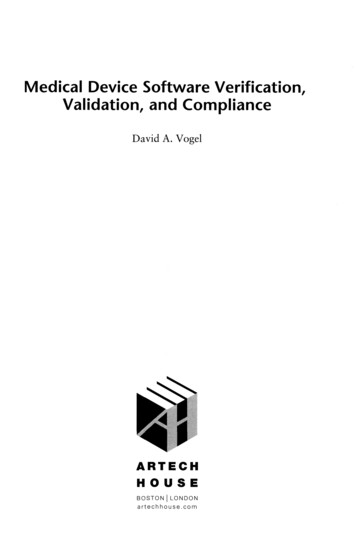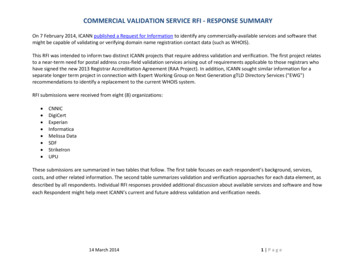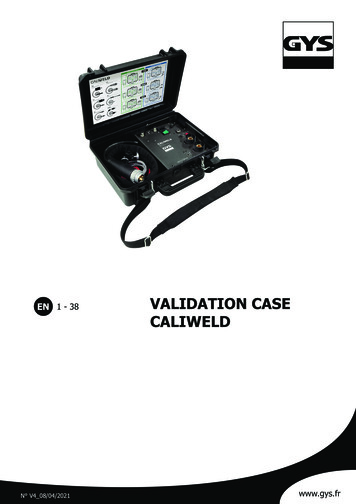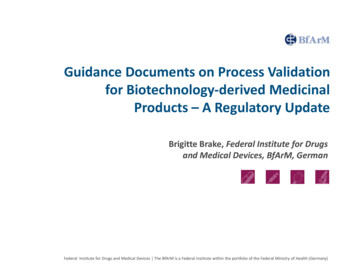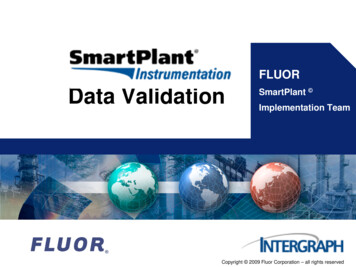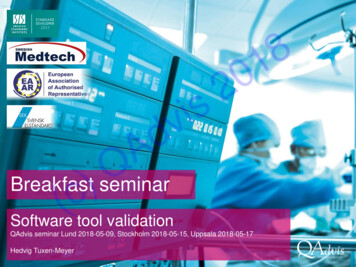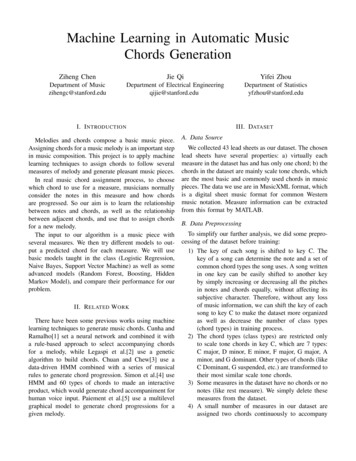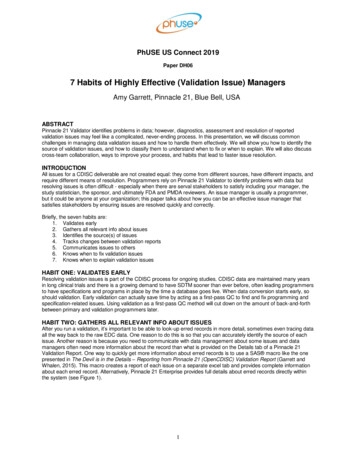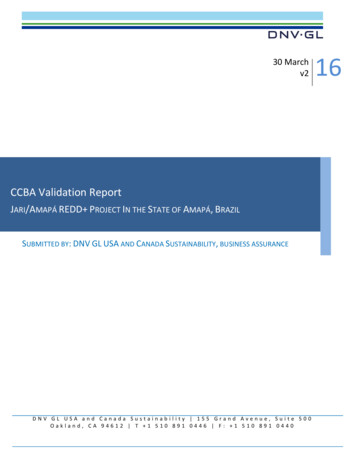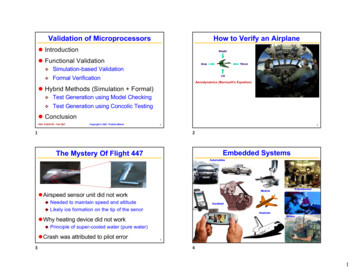
Transcription
Science Education International30(4), AL ARTICLEDevelopment and Validation of Physical Science Workbook forSenior High SchoolDanilo V. Rogayan Jr.1*, Lea F. Dollete2College of Education, Arts & Sciences, President Ramon Magsaysay State University - San Marcelino, Zambales, Philippines, 2College of TeacherEducation, President Ramon Magsaysay State University - Botolan, Zambales, Philippines1*Corresponding Author: danrogayan@prmsu.edu.phABSTRACTWith the recent implementation of the K-12 curriculum in the Philippines, teachers are challenged to develop relevant, research-based,and responsive instructional materials. At present, few reference materials for use have been prepared for the required senior high school(SHS) competencies. This study developed a workbook in physical science for SHS based on the students’ least learned concepts in agovernment-owned university in Central Luzon, the Philippines. Results revealed that the developed workbook was found to be verymuch acceptable (M 3.90) by expert validators. In particular, the workbook was acceptable in terms of adequacy (M 3.85), coherence(M 3.90), appropriateness (M 3.90), and usefulness (M 3.95). Student-validators who were enrolled in a physical science coursealso rated the workbook acceptable (M 3.79). The validated material is recommended for use as supplemental instructional tool inphysical science course in the SHS. The material which was anchored to the analysis, design, development, implementation, and evaluationmodel may serve as a prototype for the development of workbooks for other courses in the K-12 SHS curriculum. Further review andevaluation of the workbook may be considered to make it more contextualized, localized, and indigenized in the Philippine setting.KEY WORDS: instructional material; material development; physical science workbook; science education; senior high schoolINTRODUCTIONThe fast-paced changing world and the challengesof the Fourth Industrial Era continue to transformthe educational landscape of today. Educators arechallenged by the demanding task of educating GenerationZ to keep them abreast with the digital world. Globally, thePhilippines lags behind other countries in terms of the qualityof education, particularly in science education. According tothe World Economic Forum (2018), the Philippines ranked55th out of 137 participating countries in terms of highereducation and ranked 76th out of 137 countries in the qualityof math and science education.The state of science education today is influenced by severalproblems specifically the issue of inadequate instructionalmaterials and teaching tools aligned to the learning outcomesprescribed by the department of education (DepEd). Teachersfind it difficult to teach some science concepts and principlesdue to the scarcity of relevant, responsive, and researchbased learning materials. According to Jalmasco (2014), thelack of science education facilities is reflected in the poorquality of basic science and math education seen by the lowachievement scores of Filipino students in various tests. Inaddition, instructional materials that are aligned to the targetcompetencies are lacking.In 2016, the Philippine DepEd started the implementation ofthe senior high school (SHS) across the country. The SHS284aims to equip high school students for work, entrepreneurship,higher education, or middle – level skills development. This isa step up from the 10-year cycle, where high school graduatesstill need further education to be ready for the world (DepEd,2016). It covers the past 2 years of the K-12 program andincludes Grades 11 and 12, where students go through a corecurriculum and subjects under a track of their choice.In the curriculum, physical science is one of the core subjectsoffered across all tracks in Grade 11 and Grade 12, whichrequires 80 h/semester. The course deals with the evolution ofone’s understanding of matter, motion, electricity, magnetism,light, and the universe from ancient times to the present. Itincludes the application of physics and chemistry conceptsin contexts such as atmospheric phenomena, cosmology,astronomy, vision, medical instrumentation, space technology,drugs, sources of energy, pollution and recycling, fitness andhealth, and cosmetics (K to 12 Senior High School Curriculum– Physical Science, 2016). Teachers teaching the physicalscience course have been faced with the inadequacy of K-12ready materials. The development of learning materials thatfoster inquiry is an emphasis of curricular reform in K-12science because inquiry has become a core element of scienceeducation over the past few decades (Meyer et al., 2013;Trumbull et al., 2005).Several studies on the development of instructional materialsin science have been made in the Philippines. These studiesfocused on the development and evaluation of microlabScience Education International Volume 30 Issue 4
Science Education International30(4), n and Dollete: Development and validation of physical science workbookkits (Evangelista et al., 2014; Ocampo et al., 2015; Pastoret al., 2015), development of modules in physics (Auditorand Naval, 2014; Gagarin, 2003), development of sciencelaboratory manual (Bayle, 2004), validation of workbook inscience (Rubo, 2005), and module development for scienceinvestigatory project (Libranda, 2004). However, there are veryfew studies conducted on the development and validation ofthe workbook for SHS science.With the issues on the scarcity of learning materials, teachersare challenged to develop appropriate instructional materialsthat may enhance student learning and may resolve thedilemma on the scarcity of reference materials. In responseto the K-12 SHS curriculum, the development of the physicalscience workbook aims to facilitate more effective instructionin concretizing abstract concepts in physical science and tomaximize the learning experience through the developedworkbook, despite the limited resources in the public secondaryschool setting. This innovation is hoped to respond to thepressing need of basic education.Conceptual FrameworkHofstein and Naaman (2007) argued that science cannotbe meaningful to students without worthwhile practicalexperiences in the school laboratory. The K-12 basiceducation curricula must harness the 21st-century skills of thestudents. These skills include learning and innovation skills,information, media and technology skills, and life and careerskills (Partnership for 21st Century Skills, 2009). The mainpurpose of this study was to develop and evaluate an activitybased, learner-centered, and competency-based workbook onphysical science that could be used in the lecture classes inthe SHS.education; (2) establish the content and face validity of theworkbook; (3) pilot test the workbook to an identified class;(4) validate the workbook; (5) revise/improve the workbook;and (6) evaluate the developed workbook.METHODOLOGYResearch ModelThis descriptive-developmental educational research focusedon the development of instructional material in the form of analternative workbook to facilitate learning of the least-learnedand least-practiced concepts and skills of students in the SHS.Research ParticipantsThe study involved three groups of participants. The firstgroup of participants was 50 randomly sampled undergraduateteacher education students from a government-run universityin Central Luzon, the Philippines. The participants satisfiedthe following selection criteria: (1) A bona fide student ofthe university during the Academic Year (AY) 2014–2015;(2) enrolled under the program Bachelor of SecondaryEducation (BSEd) or Bachelor of Elementary Education;and (3) taking the physical science course at the time of thestudy. An informed consent form was secured before theinvolvement of the participants. These students were givena diagnostic test to determine the least learned competenciesin physical science.The second group of participants was the four expert-validators.These validators included one expert on instructional materialdevelopment and three content experts. They evaluated theworkbook’s face and content validity based on the adequacy,coherence, appropriateness, and usefulness.Figure 1 shows the input-process-output model where a needsassessment and review of existing books were made, as partof the input (I). The process (P) included the design anddevelopment of the workbook, pilot of the workbook withcollege freshmen, revision of the workbook, and the finalevaluation. The output (O) of this study was a validated andevaluated Physical Science Workbook.The third group of participants was the 24 students whoevaluated the effectiveness of the activities in the workbookusing the student’s evaluation checklist. These students wereenrolled in natural science one (physical science) course duringthe AY 2015-2016.Purpose of the StudyThe 30-item diagnostic test measured the least learnedcompetencies of the students in physical science. The testwas subjected to content and construct validity. The inter-itemreliability was found to be high based on the item analysisconducted.The study aimed to develop and validate a workbook inphysical science for SHS students. Specifically, this studyaimed to (1) develop a physical science workbook, which wascongruent with the K-12 competencies and outcomes-basedResearch InstrumentsDiagnostic testExpert validator’s instrumentInputNeeds assessment(Least LearnedConcepts)Review of existingscience books.ProcessDesign anddevelopment ofPhysical ScienceWorkbookTry out and revisionof the workbookOutputValidated andEvaluatedworkbook inPhysical Science(Proton Workbook)Evaluation of theworkbookFigure 1: Paradigm of the studyScience Education International Volume 30 Issue 4The expert validator’s instrument was a standardizedevaluation tool for the instructional materials adopted fromthe College of Education, Arts and Sciences of the University.Student evaluation checklistThe student evaluation checklist was a researcher-madeinstrument subjected to content and construct validity.Likewise, the checklist was subjected to a reliability test andobtained a Cronbach’s alpha value of 0.87 suggesting that theitems have relatively high internal consistency.285
Science Education International30(4), n and Dollete: Development and validation of physical science workbookData CollectionThe product development of the workbook followed theADDIE model (Figure 2). The Analysis, Design, Development,Implementation, and Evaluation (ADDIE) is an acronym forADDIE. This model guides you through the process of creatingeffective educational courses and materials for your audience(Instructional Design, 2015). It is an instructional design model thathas withstood the test of time and use. It is simply a “device” to helpus think through a course’s design. Although the model appearslinear, it does not have to be followed rigidly or in a linear approach,especially if you already have course materials developed.The following phases were followed in the study based on theADDIE model:Phase 1. Analysis: A diagnostic test among 50 undergraduateteacher education students was conducted in AY 2014–2015.This was to determine the least learned competencies inphysical science, which became the basis of the activitiesincluded in the workbook. Likewise, the researchers reviewedselected physical science books published in the Philippinesas part of the needs assessment.Phase 2. Design: The researchers agreed for the selection oflearning objectives, assessment instruments, and content ofAnalysis. Needs Assessment of LeastLearned Concepts in Physical Scienceand Review of Existing TextbooksDesign. Selection of Learning Objectives,Assessment Instruments and Content.each of the worksheets. Each worksheet contains the followingparts: Introductory statement, learning outcomes, learningtasks, add-on vocabulary, and suggested readings.Phase 3. Development: The researchers started writing theworksheets to be included in the workbook. Activities thatwere included are student-centered and reflective in nature.Phase 4. Implementation: Before the actual use of the workbook,the researchers subjected it to an expert validation to gauge theworkbook’s face and content validity based on the adequacy,coherence, appropriateness, and usefulness. Four experts wererequested to complete the expert validator’s form. The groupcomprised of an Associate Professor specialized in instructionalmaterial development, an Associate Professor who is an expertin Chemistry, an Assistant Professor specialized in Physics, andan Associate Professor who mastered in Biology. The developedworkbook was pilot tested with 24 BSEd students who werenot part of Year 1 of the study. The workbook was pilot testedin the first semester of the AY 2015–2016 from June 2015 toOctober 2015. After each activity, student-participants wereasked to evaluate the acceptability of each worksheet using thestudent evaluation checklist.Phase 5. Evaluation: Experts’ and students’ verbal suggestionsand comments were taken into consideration for the revisionof the material. The revised workbook was then subjected tofinal evaluation.RESULTS AND DISCUSSIONThis study is all about the development and validation of aphysical science workbook intended for SHS students. Theworkbook is supplemental material to the learning materialsprescribed by the DepEd.The Developed WorkbookDevelopment. Writing of the worksheetsand developing appropriate activities.Implementation. Subjecting to expertvalidation and pilot testing of thedeveloped workbook in BSED Iclass.Evaluation. Revision&final evaluation formass production.Production of Proton: Physical ScienceWorkbookFigure 2: Product development chart of the workbook using the Analysis,Design, Development, Implementation, and Evaluation model286Results of the students’ diagnostic test in physical scienceserved as the basis for the selection of concepts to be includedin the workbook. Also considered in the topic selection werethe expected competencies included in the SHS curriculumguide. Table 1 shows the final list of activities in the workbook.The activities were included based on the least learnedconcepts, as indicated in the diagnostic test and needassessment. The completed workbook was first subjected toexpert validation. Design, development, or even selection ofinstructional materials can be quite challenging depending onthe subject, goals, target audience, context, and so on (Şendururet al., 2016).The developed workbook is titled “Proton: Workbook inPhysical Science.” It contains enrichment exercises which canexpand the knowledge and understanding of the SHS studentson the basic concepts of chemistry and physics. The topicsincluded in this workbook were aligned with the competenciesrequired in the K-12 curriculum. The worksheet containedseveral parts, which included the introductory statement,learning outcomes, activity proper, add-on vocabulary, andsuggested readings (Table 2).Science Education International Volume 30 Issue 4
Science Education International30(4), n and Dollete: Development and validation of physical science workbookTable 1: List of worksheets in the workbookWorksheet numberWorksheet title12345678910111213141516Nature of scienceTools used in the science laboratoryBasic physical quantitiesSignificant figures and scientific notationConversion of measurementsClassification of matterHistorical development of atomic structureThe subatomic particlesAtomic orbitalsElectronic configurationThe periodic table of elementsWriting and naming chemical formulaMolecular weight and percentage compositionTypes of chemical reactionsBalancing chemical equationsDistance and displacement1718Speed and velocityAccelerationTable 2: Parts of the worksheetPartDescriptionIntroductory statementThe part of the worksheet, which provides aglimpse of the content of the worksheet. Thiswill give a prompt to the learners about thetasks to be accomplishedIt serves as the targets to be achieved at theend of the worksheet. The learning outcomescrafted are aligned with the competencies,which need to be developed among thelearnersThis part of the worksheet provides variedlearning activities, which can enhancestudents’ critical thinking, creative thinking,problem‑solving skills, and other basic scienceprocess skillsThe part of the worksheet wherein the learnerscan learn additional science vocabulary relatedto the activity performedThis part provides the list of bibliographicalentries that can be read by students to furthertheir conceptual knowledge and understandingof the topicLearning outcomesLearning tasksAdd‑on vocabularySuggested readingsThe developed workbook contains worksheets, which followthe same components, which are congruent with each other.Each worksheet has an introductory paragraph to give thestudents the idea of what topic they are working on. The learningoutcomes spell out the targets that should be attained afterperforming the different activities specified in the learning tasks.The add-on vocabulary part of the worksheet expands students’word bank in science while the suggested readings may extendthe learning of students about the topic they are working on.The material is just one instructional material that teachers andstudents could use in enriching students’ inquiry, conceptualScience Education International Volume 30 Issue 4knowledge, and understanding in physical science. The useof other learning materials to supplement the workbook isrecommended to make the learners better understand the basicconcepts of physical science. Today in most K-12 classrooms,textbooks serve as the principal tool and tutor of teaching andlearning and have an enormous influence on what is taughtin science classrooms and how the curriculum is presented(McDonald, 2016; Pingel, 2010; Roseman et al., 2001).It was assumed that well-designed inquiry-based tasks inscience textbooks play an important role in supportingstudents’ experience with scientific inquiry and developingunderstandings about scientific ideas (Yang & Liu, 2016).Content and Face Validity of the WorkbookExpert-validators were asked to validate the developedworkbook. The criteria for evaluation include adequacy,coherence, appropriateness, and usefulness (Table 3).As shown from the table, the validators strongly agreed that thedeveloped workbook showed adequacy (M 3.85; Standarddeviation [SD] 0.05). Each of the indicators received astrongly agree remarks except with the indicator on pictorialimages. It was suggested that more graphical and pictorialimages be included in the workbook. Research literaturesuggests that the quality of learning material is enhanced if thematerial is designed to take into account learners’ individuallearning styles (Rasmussen, 1998; Riding & Grimley, 1999).In terms of coherence, the developed workbook got a veryfavorable rating (M 3.90; SD 0.06) which meant that thevalidators strongly agreed in all the indicators. Although theindicator on the provision of practical work had the lowestmean, still the developed workbook was coherent with theskills to be developed. This finding supports the study ofWindschitl (2009) who clarified that coherence with existingknowledge does not mean tailoring instruction to what teachersalready know but rather taking into account their deeplyengrained theories about “good” teaching and learning.Furthermore, the validators strongly agreed on theappropriateness (M 3.90; SD 0.10) and usefulness(M 3.95; SD 0.05) of the workbook. All indicators receivedstrongly agree on remarks. It was suggested, however, thatthe developed workbook should provide more differentiatedactivities, provide immediate needs, and encourage creativeand critical thinking among the students. Content knowledgeis very important and is related to student learning (Magnussonet al., 1992). Teachers with strong content knowledge aremore likely to teach in ways that help students constructknowledge, pose appropriate questions, suggest alternativeexplanations, and propose additional inquiries (Alonzo, 2002;Gess-Newsome & Lederman, 1995; Roehrig & Luft, 2004).Table 4 shows the summary of an expert’s validation of thedeveloped physical science workbook.As reflected in Table 4, the developed workbook received avery favorable rating from the experts (M 3.90; SD 0.06)which implied that the validators strongly agreed with all the287
Science Education International30(4), n and Dollete: Development and validation of physical science workbookTable 3: Expert’s validation of the physical science workbookCriteriaMean SDRemarkAdequacy1. Instruction corresponds with activities4.00 0.002. Learning activities satisfy the stated objectives4.00 0.003. Provides independent activities4.00 0.004. Evident graphical and pictorial images3.25 0.255. Concepts presented logically4.00 0.00Weighted mean3.85 0.05Coherence1. Contains relevant activities4.00 0.002. Activities provide practical work3.50 0.293. Activities develop creativity and resourcefulness4.00 0.004. Provides relevant information for better understanding4.00 0.005. Activities conform with the concepts4.00 0.00Weighted mean3.90 0.06Appropriateness1. Adapted to intended learners4.00 0.002. Based on the NCTBS/SHS learning competencies4.00 0.003. Provides immediate needs3.75 0.254. Arranged in the correct sequence4.00 0.005. Provides varied activities to sustain interest3.75 0.25Weighted mean3.90 0.10Usefulness1. Easy to understand4.00 0.002. Provides knowledge and skill4.00 0.003. Encourages creative and critical thinking3.75 0.254. Serves as an instructional tool4.00 0.005. Helps facilitate lesson presentation4.00 0.00Weighted mean3.95 0.05Legend: Strongly agree (3.50–4.00); Agree (2.50–3.49); Disagree (1.50–2.49); Strongly disagree (1.00–1.49). SD: Standard deviationaspects of the workbook. Usefulness (M 3.95) ranked first,followed by coherence (M 3.90), appropriateness (M 3.90),and adequacy (M 3.85). The expert validators providedpositive feedback in the developed instructional material andwere hopeful for the benefits it would provide to students’learning. This finding agrees with the research findings ofseveral studies (Evangelista et al., 2014; Ocampo, 2015; Pastoret al., 2015). Tomlinson (1998) commented that the impactof instructional materials was achieved when materials havea noticeable effect on learners that are when the learners’curiosity, interest, and attention are attracted.Pilot Testing of the WorkbookThe developed workbook was subjected to initial pilottesting for further enhancements. Undergraduate teachereducation students taking up physical science course duringthe AY 2015–2016 performed the activities in the workbook.Worksheets were given after each learning session to enhancethe students’ conceptual understanding. Students were askedto assess the acceptability of the 18 worksheet activities basedon the given four-point Likert type evaluation sheet (Table 5).The student’s evaluation checklist was used to gaugethe acceptability of the developed workbook among ASATable 4: Summary of expert’s validation of the physicalscience workbookCriteriaMean SDRemarkRankAdequacy3.85 0.05SA4Coherence3.90 0.06SA2.5Appropriateness3.90 0.10SA2.5Usefulness3.95 0.05SA1Overall3.90 0.06SALegend: Strongly agree (3.50–4.00), agree (2.50–3.49), disagree(1.50–2.49), strongly disagree (1.00–1.49). SD: Standard deviation24 student-participants. Table 6 shows the summary of thestudents’ evaluation based on the workbook’s clarity ofinstructions, the attainability of learning outcomes, evidenceof varied learning tasks, visual and esthetics, vocabularyenhancement, retention of concepts, interactivity, and studentinterest enhancement.Table 6 shows that student-evaluators rated the developedworkbook to be very much acceptable as revealed by theoverall mean of 3.79 (SD 0.39). Flores (2008) found thatstudents with varied learning styles clearly preferred activitiesthat matched their learning styles. That is why the developedScience Education International Volume 30 Issue 4
Science Education International30(4), n and Dollete: Development and validation of physical science workbookTable 5: Student’s evaluation checklistItemSAADSD1. The instructions are easy to understand2. Learning objectives are attainable3. Varied activities are evident4. Graphic organizers enhanced my interest5. Word puzzles expanded my vocabulary6. The activities enhanced my understandingof the lesson7. I enjoyed answering the activities8. The activities increased my interest inphysical scienceLegend: Strongly agree (SA); agree (A); disagree (D); strongly disagree (SD)Table 6: Students’ evaluation of the activities in thephysical science workbookWorksheetWeighted mean SDRemark13.96 0.20Very much acceptable23.98 0.14Very much acceptable33.89 0.32Very much acceptable43.87 0.38Very much acceptable53.82 0.47Very much acceptable63.97 0.16Very much acceptable73.94 0.24Very much acceptable83.99 0.07Very much acceptable93.77 0.47Very much acceptable103.81 0.44Very much acceptable113.79 0.50Very much acceptable123.70 0.61Very much acceptable133.74 0.60Very much acceptable143.83 0.48Very much acceptable153.20 0.70Much acceptable163.92 0.28Very much acceptable173.58 0.49Very much acceptable183.25 0.43Much acceptableOverall3.79 0.39Very much acceptableVery much acceptable (3.49–4.00); much acceptable (2.50–3.00); not muchacceptable (1.50–2.49); not at all acceptable (1.00–1.49). SD: Standarddeviationinstructional material considered infusing various kinds ofactivities to address the multiple intelligences of the students.The results of the study are congruent to the study of Auditorand Naval (2014) which showed that the developed moduleswere found acceptable for the tenth-grade physics students.Furthermore, Flores (2008) stated that it is not necessary tomodify teaching styles, but there is a need to design activitiesto increase educational outcomes and student satisfaction.Likewise, the use of instructional materials in teachingimproves the performance of the students and enables teachersto clarify their lessons (Leonen, 2016).The evaluation results of both the experts and students werecongruent with the previous study on material development.Based on Nunan’s (1989) suggestions, good materials should:(1) Be clearly linked to the curriculum they serve; (2) beScience Education International Volume 30 Issue 4authentic in terms of text and task; (3) stimulate interaction;(4) allow learners to focus on formal aspect of the language;(5) encourage learners to develop skills in learning how tolearn; and (6) encourage learners to apply their developinglanguage skills to the world beyond the classroom.CONCLUSIONS AND RECOMMENDATIONSThe study sought to develop and validate a workbook inphysical science intended for the SHS students under theK-12 curriculum. The developed workbook was found tobe very much acceptable as validated by the experts. Theexpert-validators strongly agreed that the instructionalmaterial possesses adequacy, coherence, appropriateness, andusefulness. The “Proton: Physical Science Workbook” hadbeen evaluated as very much acceptable by the students. Theworkbook follows differentiated instruction and encouragesindependent learning. The learning material was aligned tothe competencies required in the SHS.A pre-test-post-test quasi-experimental research design mustbe conducted to assess the effectiveness of the worksheetsin improving student conceptual understanding in physicalscience. The developed instructional material may also beused by other SHS teachers in their respective classes to assesspotential problems in its utilization and to further validate itseffectiveness. Further scrutiny and review may also be done byexperts to review the concepts and principles integrated into theworkbook. The developed workbook can serve as a prototypein developing workbooks for other core courses in SHS.Since the study only involved a smaller population for thepilot-testing, further study may be done in a larger studentpopulation to further assess the workbook’s acceptability.A follow-up study may also be conducted in the future toascertain the congruence of the activities in the workbook tothe competencies required in a physical science course. The useof qualitative approach is also suggested to further determinethe workbook’s acceptability.ACKNOWLEDGMENTSThe researchers would like to thank the following peoplefor making this research possible: Dr. Luz N. Corpuz, BSEdProgram Chair, for the support and encouragement; Prof.Joseline R. Tamoria, for the constructive criticisms in theworkbook development; expert validators for the suggestions;and BSEd students (AY 2014–2015 and AY 2015–2016), forthe active participation.REFERENCESAlonzo, A.C. (2002). Evaluation of a Model for Supporting the Developmentof Elementary School Teachers’ Science Content Knowledge. Charlotte,NC: Proceedings of the Annual International Conference of theAssociation for the Education of Teachers in Science.Auditor, E., & Naval, D. J. (2014). Development and validation of tenthgrade physics modules based on selected least mastered competencies.International Journal of Education and Research, 2(12), 145-152.Bayle, N. (2004). Development and Validation of Laboratory Manual in289
Science Education International30(4), n and Dollete: Development and validation of physical science workbookPhysics (Doctoral Dissertation Eulogio “Amang” Rodriguez Institute ofScience and Technology, Manila).Department of Education (DepEd). (2016). Senior High School. Availablefro
includes the application of physics and chemistry concepts in contexts such as atmospheric phenomena, cosmology, astronomy, vision, medical instrumentation, space technology, drugs, sources of energy, pollution and recycling, fitness and health, and cosmetics (K to 12 Senior H
